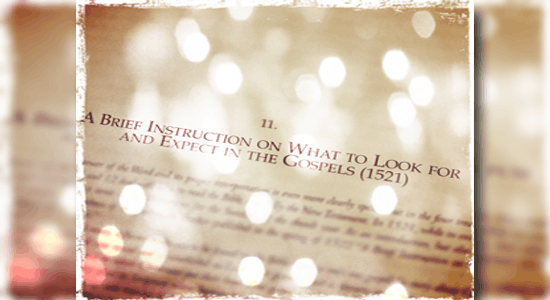
In today’s episode of 5 Minutes in Church History, Dr. Stephen Nichols takes us to Wartburg Castle and Martin Luther’s remarkable work there.
What Luther Expects
In a short text from 1522, Martin Luther told his readers what to expect to read when they read the Gospels. Now, this was an important moment in Luther’s life. In April 1521, Luther appeared before the Diet at Worms and had his famous “Here I stand!” moment. In the aftermath of that council, Luther was spirited away to Wartburg Castle, overlooking the town of Eisenach. And there, in what is truly a modest study, Luther wrote three texts.
One of them was very significant: it was a translation of the Greek New Testament into German. It’s a remarkable feat when you think that Luther was able to do that in such a short amount of time. It shows us that not only was Luther bold but he was also quite a scholar.
Another thing that Luther wrote while he was in the Wartburg was a series of sermons. These are called the Church Postils or the Kirchenpostille. They were sermons that expound upon the gospel and the main theme of the New Testament. With the Bible having been out of the reach of the church for so long, preaching had also been out of the reach of the church for so long. Luther was not only concerned with putting the Word of God in the hands of the people—hence his translation of the New Testament—but he also wanted them to understand what they were reading. So, he wrote these sermons, not so much so that they would be preached verbatim, but that these sermons would model how the Word of God should be handled from the pulpit.
As a forward to the Church Postils, Luther wrote a third text called A Brief Instruction on What to Look for and Expect in the Gospels. In it, Luther starts off by saying in effect, “Well, there’s four Gospels, right? Wrong. That is the wrong way to approach this. You have to come at this as one gospel. In fact, not only do you have to come at the four Gospels as telling the one story of the one gospel, you have to look at the Epistles as an exposition of this one gospel. What you look for when you read the Bible is the gospel.” This is what Luther says: “So, you see that the Gospel is really not a book of laws and commandments that requires deeds of us, but a book of divine promises in which God promises, offers, and gives us all His possessions and benefits in Christ.”
At another point, Luther says this about what the gospel is and about what the essence of the Bible is: “For at its briefest, the Gospel is a discourse about Christ, that He is the Son of God and became a human being for us, that He died and was raised, that He has been established as a Lord over all things.” He goes on: “This is the sum of which Paul took away from his understanding of the four Gospels and the historical Jesus,” and further, “Paul takes this in hand and spins it out in his epistles.” And then Luther also says, “The Gospel is a story about Christ—God’s and David’s Son—who died and was raised and is established as Lord. This is the Gospel in a nutshell. Just as there is no more than one Christ, so there is and may be no more than one Gospel. Since Paul and Peter, too, teach nothing but Christ in the way we have just described, so their epistles can be nothing but the Gospel.”
What do you look for and what do you expect? Well, you should look for and expect the gospel.
Stay connected with 5 Minutes in Church History by getting the weekly podcast on iTunes, SoundCloud, or via RSS. You can also subscribe to the blog via RSS and follow us on Twitter and Facebook.
(This podcast is by Ligonier Ministries. Discovered by e2 media network and our community — copyright is owned by the publisher, not e2 media network, and audio is streamed directly from their servers.)